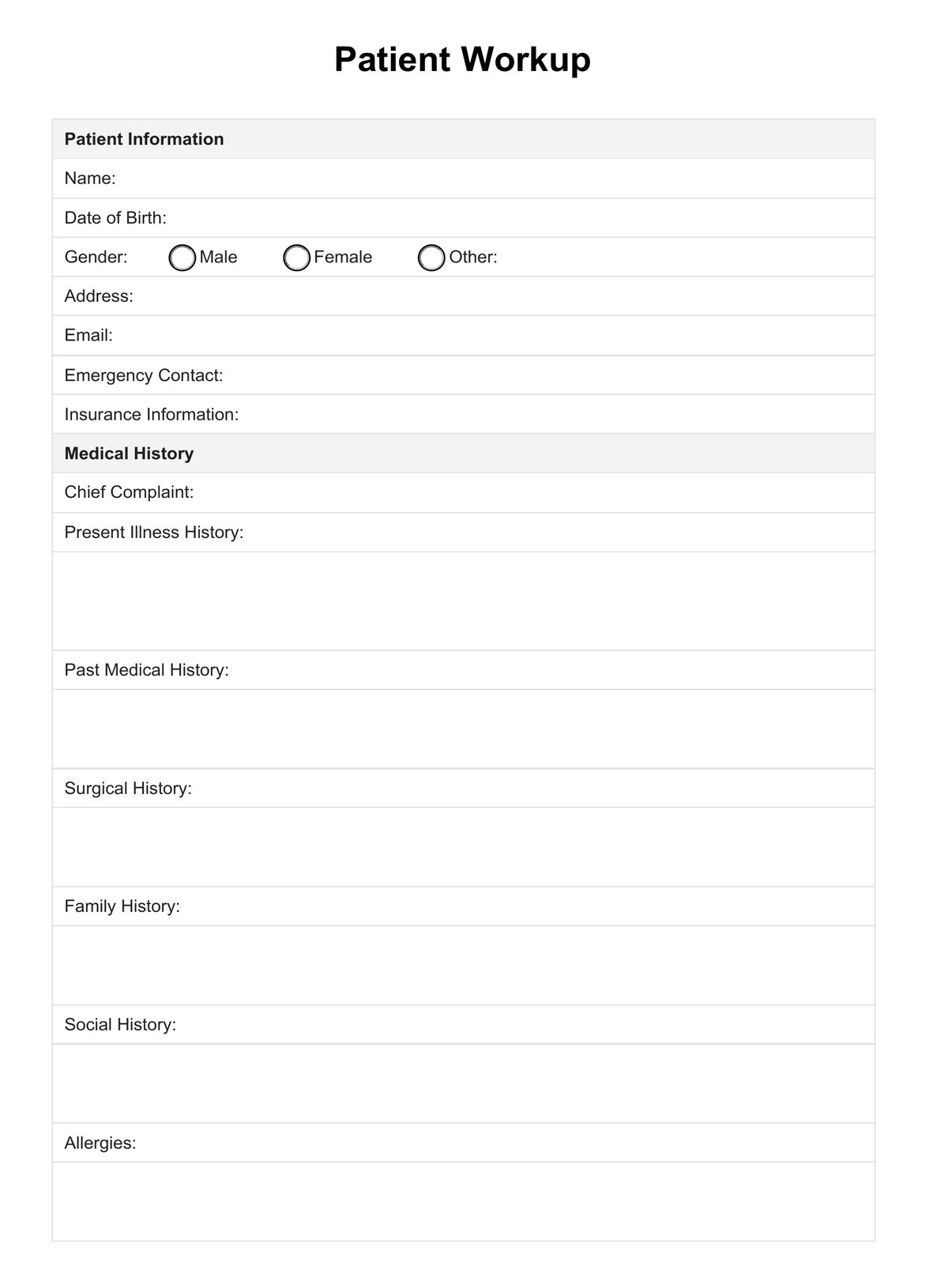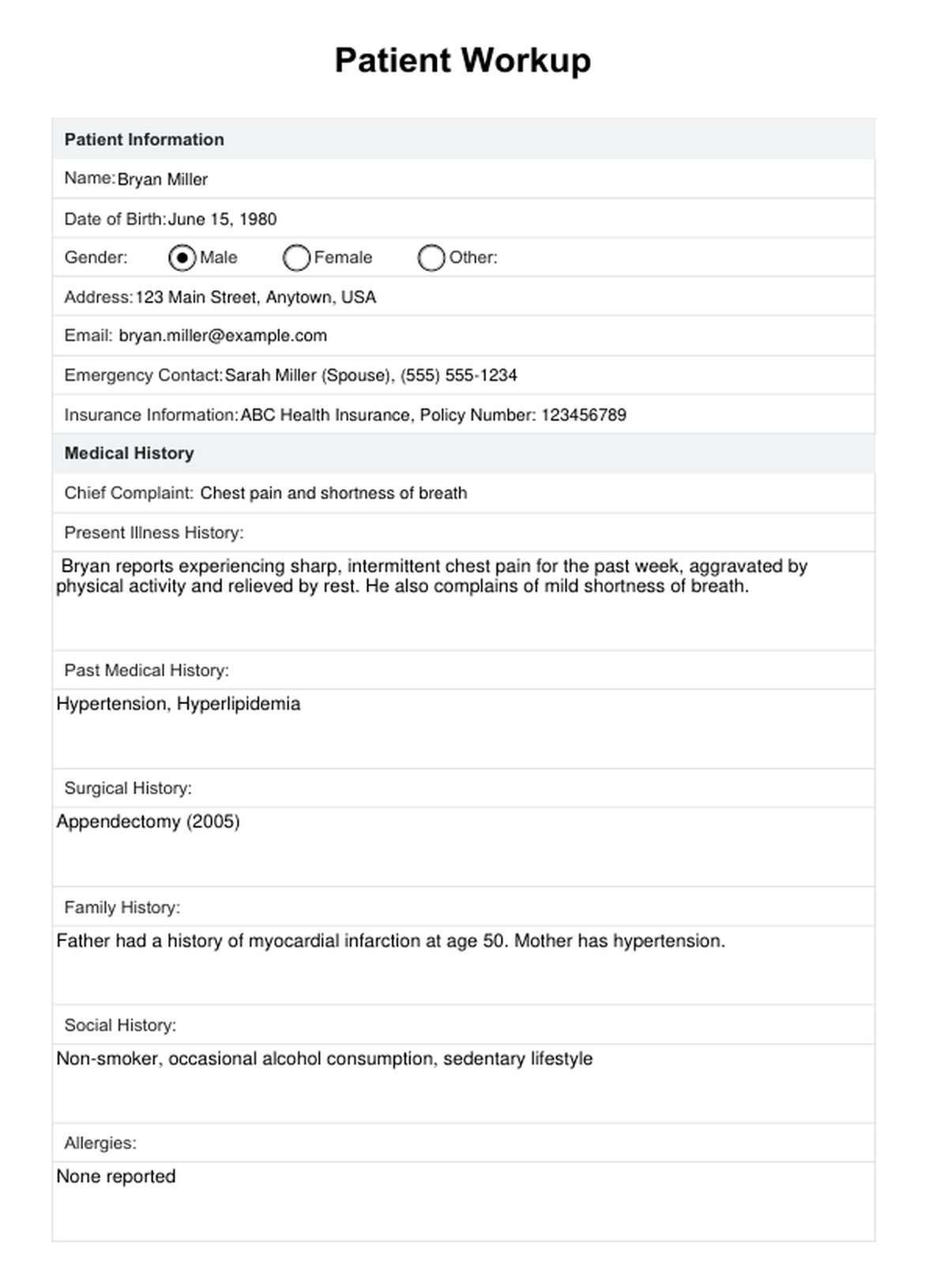
Optimize patient care with our comprehensive Patient Workup Template. Streamline assessments and treatment plans efficiently.

By Bernard Ramirez on Aug 06, 2024.


A patient workup is a systematic process crucial in healthcare for evaluating a patient's condition and determining the most effective treatment plan. It typically involves thorough patient assessment and physical examination to gather subjective and objective data essential for diagnosis and management. The primary aim is to describe desired therapeutic outcomes by identifying the patient's medical problems, including drug-related issues. Through meticulous data collection and analysis, healthcare professionals define the current medical issues, enabling them to tailor interventions to meet the patient's specific needs effectively.
Patient assessment forms the foundation of the workup, encompassing a detailed review of the patient's medical history, current symptoms, and any relevant past treatments. Physical examination complements this by providing valuable insights into the patient's physiological status, aiding in identifying potential health concerns. By collecting objective data through various diagnostic tests and assessments, clinicians can comprehensively understand the patient's health status and develop targeted interventions to address their unique healthcare needs. This holistic approach ensures that patient care is individualized and optimized, promoting better health outcomes and improved quality of life.
PDF Template Example PDF

Here are the steps healthcare professionals may follow when conducting a workup:
First, gather all necessary details about the patient, including their medical history and current complaints, to understand their health status comprehensively.
Record past illnesses, surgeries, medications, and allergies to provide context for the current health concerns and identify potential risk factors.
Conduct a thorough physical assessment to gather objective data about the patient's physiological state, including vital signs and various body systems.
Based on the initial assessment, order necessary tests such as lab work or imaging to confirm diagnoses and guide treatment decisions.
Evaluate all collected information to formulate a comprehensive assessment of the patient's health status and establish potential issues or diagnoses.
Create a personalized treatment plan tailored to the patient's needs and therapeutic goals, incorporating medication, lifestyle changes, and referrals as necessary.
Utilize digital platforms to streamline documentation and communication, reducing paperwork and enhancing collaboration among healthcare team members.
Regularly monitor the patient's progress and make necessary adjustments to the treatment plan to ensure optimal outcomes and satisfaction.
After completing the initial assessment and documentation process using the Patient Workup Template PDF, the following steps involve collecting objective data further to refine the patient's diagnosis and treatment plan. This may include ordering laboratory tests, imaging studies, or other diagnostic procedures to gather additional information and confirm findings.
Once the diagnostic studies are completed, healthcare professionals can analyze the results to more precisely define the current medical problems. By synthesizing subjective and objective data, clinicians can identify patient-specific issues and tailor interventions accordingly, ensuring a personalized approach to care.
In some cases, intensive diagnostic studies may be necessary to thoroughly investigate complex or challenging medical conditions. These studies may involve specialized imaging techniques, genetic testing, or consultations with multidisciplinary teams to comprehensively understand the patient's health status and effectively guide treatment decisions.
Using a Patient Workup Template can streamline clinical documentation and organization. Here are other benefits of using this document:
Utilizing the Patient Workup Template allows for systematic organization and documentation of patient information, enabling healthcare practitioners to collect objective data accurately and efficiently. This streamlines the assessment process, saving time and ensuring thoroughness inpatient evaluation.
By following the structured format of the template, healthcare providers can define current medical problems more precisely, leading to better diagnosis and treatment planning. This clarity helps streamline communication among healthcare team members, enhancing collaboration and patient care delivery.
The comprehensive nature of the Patient Workup Template provides a solid foundation for conducting intensive diagnostic studies when needed. This ensures that complex medical conditions are thoroughly investigated, leading to accurate diagnosis and appropriate treatment interventions.
Pharmacists benefit from the organized documentation provided by the Patient Workup Template, allowing for better medication management and adherence monitoring. With clear patient information at their disposal, pharmacists can make informed decisions regarding medication therapy, contributing to patient safety and outcomes.
Hospital administrators benefit from the standardized documentation facilitated by the Patient Workup Template, leading to improved efficiency in patient care processes. By streamlining workflows and promoting consistency in documentation, the template contributes to better resource allocation and overall hospital management.
You can use the Chest Pain Workup Template to systematically evaluate and diagnose the underlying causes of chest pain in your patients. This template helps ensure a thorough assessment by guiding you through relevant tests and evaluations, ultimately aiding in accurate diagnosis and effective treatment planning.